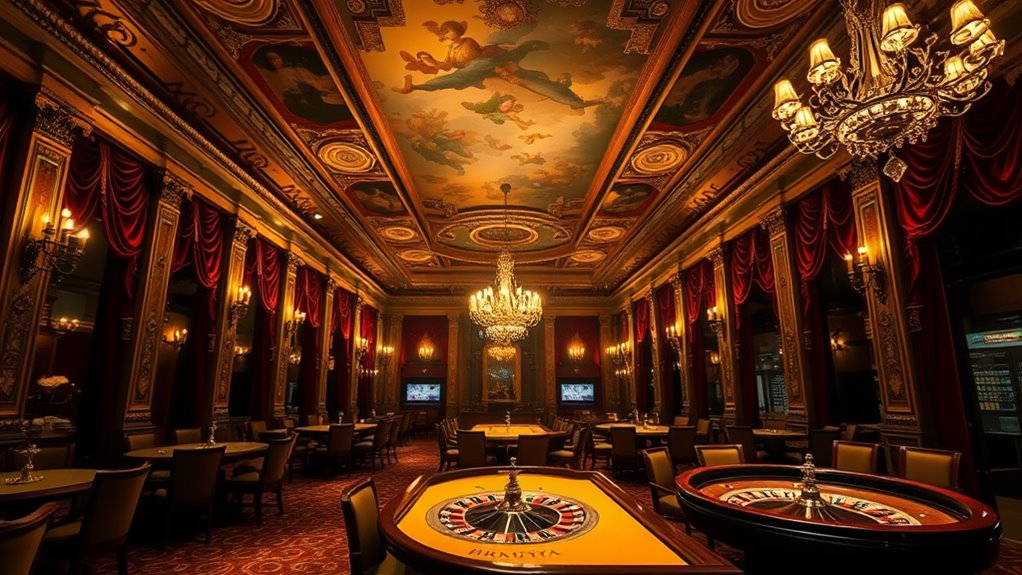You’re about to enter a domain where chance and fate entwine, where the roll of a dice or the spin of a wheel have become a timeless muse for artists and writers, echoing the human condition in all its complexity. You’ll witness the opulent 19th-century gambling dens of the aristocracy, the Impressionists’ brushstrokes of Europe’s late 19th-century casinos, and the literary echoes of the Lost Generation. And if you’re intrigued by the allure of these grand establishments, consider exploring casinos con bonos de bienvenida sin depósito for a modern taste of excitement and the thrill of the game. As the curtains draw open, a nuanced exploration awaits, weaving together art, literature, and the dizzying allure of the casino world.

19th-Century Europe: Gambling Dens of the Aristocracy
As you explore 18th-century European art and literature, the opulent gambling dens of the aristocracy emerge as a recurring motif, epitomizing the era’s complex relationship with chance, morality, and social hierarchy.
You witness the alluring world of secret salons, where aristocrats indulge in games of chance, exhibiting a penchant for aristocratic decadence.
Lavish parties, clandestine meetings, and scandalous affairs are all woven into the fabric of these underground establishments.
In this rarefied atmosphere, you notice how art and literature intersect with the tumultuous lives of gamblers, courtesans, and other high-society individuals.
The likes of Casanova and de Laclos record this excess in their writings, reinforcing the notion that, in this gilded age, morality is an ambiguous concept, and chance a ruling force.
The Impressionists’ Brush With Casinos
Numerous works by the Impressionists testify to the enduring allure of casinos in late 19th-century Europe.
You find yourself immersed in the enchanting world of Casino landscapes, as envisioned by Impressionist artists. Edgar Degas’ “The Gaming Table” and Édouard Manet’s “The Salon at the Rue de Rivoli” exemplify the fascination of these artists with the glamour of casinos.
As you gaze upon these masterpieces, you notice the emphasis on light, color, and movement, which bring the vibrant atmosphere of the casinos to life. The Impressionists’ brushstrokes seem to dance across the canvas, capturing the whirlwind of emotions that swirl around the gaming tables.
You can almost hear the soft murmur of conversation, the rustle of dresses, and the clinking of glasses.
Early 20th-Century Portrayals: From Vice to Virtue
How does the representation of casinos shift in the early 20th century, reflecting the changing societal values of the time?
You observe a more nuanced approach to depicting casinos, one that blurs the lines between vice and virtue. The rigid moral dichotomy of the past gives way to a more complex exploration of human nature.
Casinos are now often seen as microcosms of society, where people from all walks of life converge, and their stories unfold. You note how authors begin to harness gambling symbolism to explore themes of chance, risk, and fate, reflecting the growing sense of disillusionment and uncertainty in the aftermath of World War I.
The casino becomes a potent symbol for the human condition, embodying both the thrill of possibility and the specter of loss.
The Lost Generation: Hemingway and the Casino Culture
The labyrinthine corridors of casinos proved a fitting backdrop for the disillusioned protagonists of Ernest Hemingway’s works. As you explore the world of Lady Brett Ashley in The Sun Also Rises or the mercenary pursuits of Thomas Hudson in Islands in the Stream, you notice how the author masterfully wields casino settings to illustrate the emotional decay of his characters.
Hemingway’s use of casinos as a metaphor for the disillusionment of the Lost Generation adds a layer of depth to his narratives. The bittersweet longing for a bygone era—casino nostalgia—permeates his fiction, exposing the darker underbelly of the human condition.
Through subtle Hemingway symbolism, you’re invited to confront the moral ambiguity that lies at the heart of his characters’ decisions.
Modern Representations: Glitz, Glamour, and Social Commentary
Glamorous casino settings and big-stakes betting have captivated modern authors, who wield these elements to craft scathing social commentary.
As you explore modern representations of casinos in literature, you encounter a world of neon aesthetics and excess. Authors use these settings to critique societal norms and expose the coercive nature of capitalism.
You see this in works that juxtapose the allure of casinos with the stark reality of addiction, economic inequality, and social stratification. Through these narratives, you’re forced to confront the darker side of the glamorous façade.
This cultural critique serves as a searing indictment of the systems that perpetuate these destructive behaviors, leaving you to ponder the true cost of the high-stakes world of casinos.